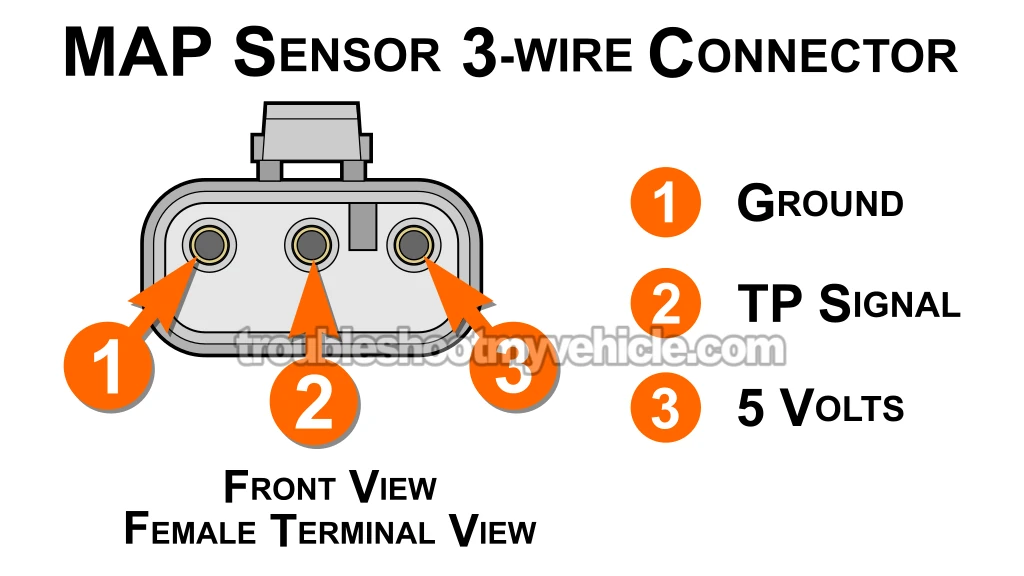TEST 3: Verifying The MAP Sensor Ground Circuit

OK, based on the last two tests, here's what we've found:
- First, the MAP sensor isn't producing a changing voltage signal when you apply or release vacuum (TEST 1).
- Second, the MAP sensor is getting power —specifically 4.5 to 5 Volts DC (TEST 2).
For the final check, we're going to see if the sensor is receiving a proper Ground signal. We'll use a multimeter for this.
It's a pretty straightforward test. You'll be checking the black wire with light blue stripe (BLK/LT BLU) of the MAP sensor's 3-wire connector. This is the wire responsible for delivering Ground to the sensor.
IMPORTANT: This wire connects directly to the fuel injection computer, so be careful. Do not short it to battery voltage (12 Volts) —you could seriously damage the computer. The voltage test I outline in the instructions below is a safe way to check for Ground in this circuit.
Here are the steps for the test:
- 1
Disconnect the MAP sensor from its electrical connector.
- 2
Connect the red multimeter test lead to the battery positive (+) terminal.
- 3
Set your multimeter to Volts DC mode.
- 4
Turn the key ON but don't start the engine.
- 5
Probe the terminal marked with the number 1 using the black multimeter test lead.
This terminal should connect to the BLK/LT BLU wire of the connector. - 6
Your multimeter should display 10 to 12 Volts DC.
Here's what your results tell us:
CASE 1: Multimeter shows 10 to 12 Volts. That tells us it's definitely getting power from the computer.
At this point, the sensor is bad and should be replaced—but only if you've also confirmed all of the following:
- The MAP sensor doesn't produce a variable voltage when you apply and release vacuum (TEST 1).
- It's getting proper power —4.5 to 5 Volts DC (TEST 2).
- It's receiving Ground (which we just confirmed in this section).
Want to save a little money on the replacement? Check out my recommendations: Where to Buy the MAP Sensor and Save.
CASE 2: Your multimeter didn't show you 10 to 12 Volts. Double-check all your connections and retest.
If you're still not seeing 10 to 12 Volts, you've found the reason why the MAP sensor isn't be able to generate its variable voltage signal.
At this point, you can rule out the MAP sensor itself as the problem. Your next step is to restore this missing Ground supply. The most common issues are:
- A break or fault in the 5 Volt supply wire between the MAP sensor's 3-wire connector and the fuel injection computer.
- A less common, but possible, issue inside the computer itself.
MAP Sensor Code Won't Go Away
OK, so you've already tested your MAP sensor and it seems to be working just fine. But that check engine light just won't go away —even after clearing the diagnostic trouble code (DTC) from the computer?
Let's dig a little deeper. Here are a few possible causes you might be overlooking:
- Major vacuum leak: You could be dealing with a serious vacuum leak. This leans out the air/fuel mixture, causes rough idling, and can fool the fuel injection computer into thinking the MAP sensor is the problem.
- Damaged vacuum hose: Check the rubber hose that connects the MAP sensor. If it's dried out, cracked, or broken, that could be your issue.
- Low engine compression: If several cylinders have low compression, it can lead to rough idling and unstable vacuum. Run a compression test to confirm:
- Intermittent MAP sensor failure: The MAP sensor might be acting up—working fine sometimes, then failing intermittently. Try gently tapping it with a screwdriver handle while applying vacuum. If the voltage reading jumps or glitches, that's your culprit.
- Damaged MAP sensor connector: Take a close look at the MAP sensor connector. If the locking tab is broken, the connection might be loose and causing intermittent problems.
- Failing fuel pump: The fuel pump may be on its way out. If it's not supplying enough fuel or pressure to the injectors, you'll get poor performance and DTCs. Check the fuel pressure and make sure it's within spec:
More 3.9L V6 Dodge Ram Van Tutorials
I've written several more tutorials for the 3.9L V6 Dodge Ram vans and you can find them in this index:
Here's a sample of the tutorials you'll find in the index:
- How To Test For A Blown Head Gasket (1989-2003 3.9L V6 Dodge Ram Van).
- How To Test The Engine Compression (1989-2003 3.9L V6 Dodge Ram Van).
- How To Test The Fuel Pump (1989-1991 3.9L V6 Dodge Ram Van).
- How To Test The TPS (1991 3.9L V6 Dodge Ram Van).

If this info saved the day, buy me a beer!

